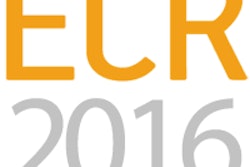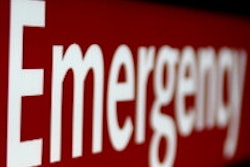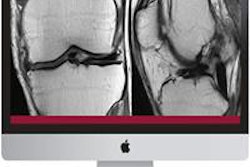
Residents can safely perform triple rule-out CT exams when onsite or on-call subspecialty radiologists aren't available -- at least at the Medical University of South Carolina (MUSC) in Charleston, SC -- according to a study presented at ECR 2014 in Vienna.
Residents missed a few more minor findings on triple rule-outs than they did on other types of CT exams. However, they missed no more major findings than experienced subspecialty attending radiologists for patients with emergent chest pain, concluded researchers from the Medical University of South Carolina (MUSC).
Triple rule-out studies are generally defined as gated cardiac CT angiography exams with bolus tracking optimized for detecting three clinical conditions: coronary atherosclerosis, pulmonary embolus, and aortic dissection. They enable radiologists to quickly rule out three common causes of chest pain without sending patients on to other imaging exams.
 Dr. A.J. Lewis from MUSC.
Dr. A.J. Lewis from MUSC.
But acquiring and analyzing that much data can be a tricky job, leading to concerns about whether residents are up to the task. Therefore, the MUSC group decided to perform a study to determine the discrepancy rate between resident interpretations of emergent triple rule-out studies compared to other types of CT exams, and they also compared residents' performance to that of attending physicians for triple rule-out exams.
Studies with other imaging modalities have shown a small but significant rate of major discrepancies likely to affect patient management, at approximately 2% for overnight on-call residents who are interpreting imaging studies, said Dr. A.J. Lewis of MUSC. As for minor discrepancies, the rate is estimated to be higher -- about 20% across all on-call emergency imaging studies.
The study took place over a two-year period at a busy academic center, with approximately 617 electrocardiogram (ECG)-triggered triple rule-out exams performed. For a control group, the researchers used 609 emergency-room-ordered chest CTs, including 465 CT pulmonary angiography (CTPA) studies, 75 standard contrast-enhanced chest CT exams, and 69 noncontrast chest CTs.
"At our institution, interpretation of these studies, both for the control group and the triple rule-out group, are provided by third- and fourth-year residents, all of whom have completed at least one month-long cardiac dedicated training," Lewis said.
The facility uses a commercially available automated grading system, with discrepancies coded as either likely to be significant and affect patient management, or unlikely to be significant. Data were analyzed using Pearson's chi-squared test.
"We showed no significant difference in major discrepancies between the chest CT group and the cardiac triple rule-out CT group, but there were significantly more minor discrepancies in the cardiac triple rule-out group," he said. Overall, for any discrepancies, the rate was approximately 11% in the triple rule-out group and 7% in the control group (p = 0.008).
"The differences were only because of the minor discrepancy rates; major discrepancies were actually slightly lower in the triple rule-out group, although this was not significantly different," Lewis said.
| Discrepancies in CT triple rule-out exams | |||
| Triple rule-out group (n = 607) |
Control group (n = 609) |
p-value | |
| All discrepancies | 11.2% (n = 69) | 6.7% (n = 41) | 0.008 |
| Minor discrepancies | 9.1% (n = 56) | 3.9% (n = 24) | < 0.001 |
| Major discrepancies | 2.1% (n = 13) | 2.8% (n = 17) | 0.55 |
The 13 major discrepancies in the triple rule-out group included four cases in which residents overcalled the degree of coronary atherosclerosis. These were considered major discrepancies because they affected patient management. Other major discrepancies included one case each of the following:
- Missed anomalous origin: intra-arterial course of right coronary artery
- Missed global hypokinesis, with left-ventricular enlargement and heart failure
- Overestimation of calcium score
- Missed displaced sternal body fracture that was the likely cause of the patient's chest pain
- Low ejection fraction
- Esophagitis
- Left-ventricular hypertrophy
- Pericarditis
- Mediastinal lymphadenopathy
Sources of minor discrepancies were also analyzed, as shown in the table below.
| Sources of minor discrepancies in triple rule-out exams | ||
| Category | No. of cases with discrepancies | Most common discrepancies |
| Extrathoracic | 12 | Missed hepatic lesions (n = 8) |
| Coronary | 9 | Overcalling degree of coronary stenosis (n = 6) |
| Congenital coronary | 9 | Missed ventricular septal defect (n = 4) |
| Pulmonary parenchymal | 7 | Missed pulmonary nodules (n = 5) |
| Cardiac noncoronary | 7 | Subtle wall-motion abnormalities |
Minor misses in the control group included pulmonary nodules (n = 9), missed splenic lesions (n = 5), and missed subsegmental pulmonary emboli (n = 5), Lewis said.
Lewis cited a number of study limitations, including the use of subjective criteria from the commercial grading application, potential variability between attending radiologists in what constitutes a significant finding, and limitations inherent in generalizing the results to all training programs that may provide less rigorous training in cardiac CT. Finally, the control group included a significant number of noncontrast chest CT scans, he said.
"The bottom line ... is that there's not a compelling reason to treat this test any differently from any other imaging modalities that are interpreted overnight by the residents on call -- and triple rule-out studies can be utilized safely by on-call residents," Lewis said.




















